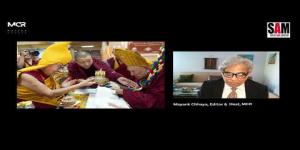Lapdog TV journalism scripting a disgraceful chapter in India's media history
A coinage about the Indian media that has gained currency in recent years is 'godi' media, which roughly translates into lapdog journalism

A coinage about the Indian media that has gained currency in recent years is 'godi' media, which roughly translates into lapdog journalism. 'Godi' means lap in Hindi and the lap on which the television news presenters are supposed to be sitting is that of the government. Day in and day out, the anchors of these docile TV channels churn out news and views that are blatantly biased in the ruling Bharatiya Janata Party’s (BJP) favour.
Since prejudice is their lifeblood and appears to be serving them well in a competitive environment, it is obvious that they have hit a lodestone of sorts which attracts audiences in droves. Unless this was the case, the channels would not have persisted so earnestly with their one-sided coverage. It is not only in India that the godi, or establishment, media holds sway over sizeable section of the viewers. The Fox news in the US is another such channel with a pronounced tilt towards the ruling Republican party.
However, it cannot be gainsaid that such partiality is not only a new phenomenon in the newspaper and television industry, but used to be deemed earlier as a losing proposition by the movers and shakers of the market. The reason why they did not believe that prejudice pays is the conviction that readers and viewers look for an impartial assessment of the social and political events and are put off by a slanted presentation which, ipso facto, cannot be trusted and that it is waste of money, therefore, to subscribe to such newspapers and channels. Little wonder that in those days of a discerning audience, the party newspapers had a limited circulation in contrast to what was considered mainstream publications which built their reputations on being fair.
Not only newspapers, radio and television stations like the BBC, too, set a high standard in unbiased coverage and had a worldwide spread of listeners and viewers. In course of time, nearly all radio and television broadcasters aspired to be recognized as objective and dispassionate, except those in totalitarian countries. Old-timers in India will remember that even All India Radio, now a part of the establishment media along with Doordarshan, the two public broadcasters under Prasar Bharati, had a high reputation for credibility with newsreaders like Melville de Mello, Roshan Menon, Latika Ratnam and Surajit Sen becoming household names for reliability.
The insistence on objectivity in these media outlets went hand in glove with the highly readable letters to the editor columns in well-regarded newspapers which not only reflected a wide range of views, but also presented well-informed and even scholarly dissertations. While the letters column in the Times of London found mention in literary works, the Statesman in Calcutta (as the city was known then) also had a high enough reputation for celebrated film-makers like Satyajit Ray and Mrinal Sen to indulge in their professional rivalry in the newspaper’s letters column.
It is noteworthy that the injection of a pro-government bias in sections of the media, especially television, has coincided with the disappearance of letters from newspapers and has been followed by the storming of laptops and mobile phones by missives from trolls which are marked by abuse and ignorance in as high a measure as were civility and punditry of the letter writers of a bygone age. It may not be besides the point to mention that this transition from fairness to crudity has coincided with the rise of right-wing political forces in both India and the US.
While the left-liberals, too, once had their days in the sun, their followers were rarely as foul-mouthed as today’s right-wing netizens. Moreover, the left-liberals hardly had any newspaper in their thrall except those run by their parties. There were no private TV channels in those days; they came only in the eighties after Prime Minister Rajiv Gandhi opened up the airwaves to private broadcasters. Today, it is the venom spouted by the far-right which is on display on TV.
Arguably, it is the single-minded focus of their diatribes which draws their viewers who are not bothered by the absence of a nuanced presentation of a complex subject or the iron-clad conventions of an earlier period when it was mandatory to present both the sides of a case. Even if a laboured attempt is made nowadays to have contrarians in a television studio, they are shouted down more often than not or branded as unpatriotic and even traitors while the host and his/her favoured guests stridently voice their opinions which are unabashedly highlighted as the correct one.
Before China became the main talking point, the twin targets of the establishment media were the Congress and Islamists. The two have always been linked in the minds of the rightists. According to them, it is the appeasement of Muslims by the Congress which has raised the vision among the minorities of a rerun of the Mughal raj, as BJP MP. Tejasvi Surya warned parliament. The establishment media regard as their bounden duty, therefore, to caution the nation against such a fateful turn of events. In the process, they are writing a disgraceful chapter in India’s media history.
(The writer is a commentator on current affairs. The views expressed are personal.)












Post a Comment